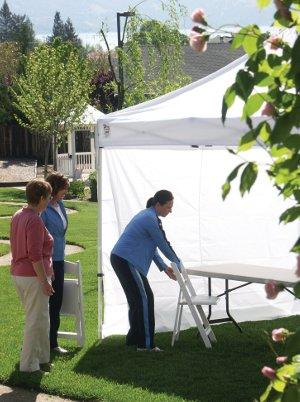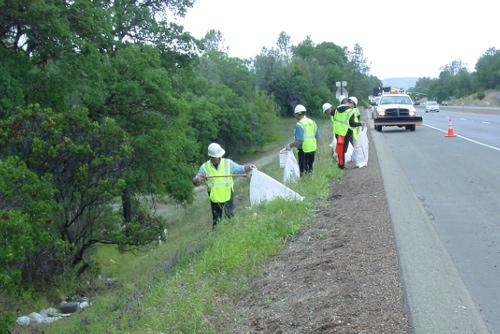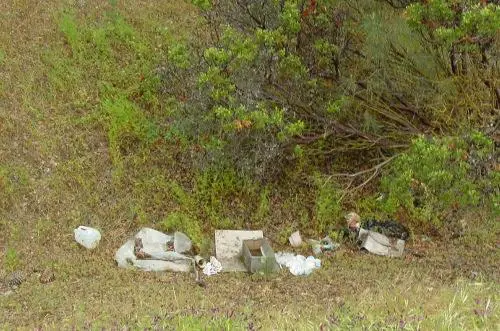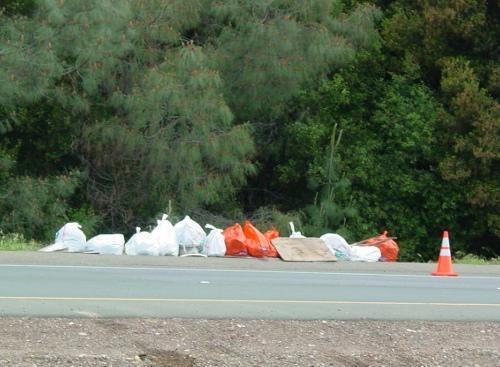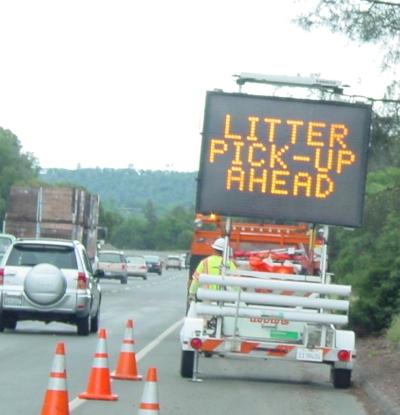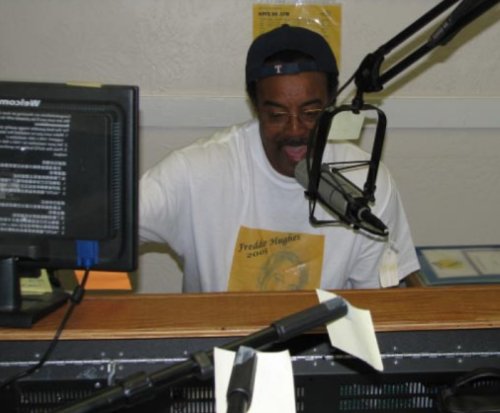
T. Watts at the KPFZ microphone. Courtesy photo.
I see people victim
prices rising
gas shortage
and the dollar devalue
Crystal Ball
Peter Tosh circa 1979
As I explained last week, I was able to actually speak with Bob Marley during the Wailer’s second North American Tour in the late 1970s. Though it seemed like a tiny quirk of fate at the time, I believe it was the signal from On High that music journalism was to be an integral part of my career path.
I saw Bob Marley & The Wailers at the famous San Francisco nightclub, the Boarding House. It was a sold-out event. Somehow, as I recall, I ended up with an extra ticket. I think I was stood up.
I remember the power and energy of the Wailer’s set. It was definitely a spiritual experience. What puzzled me was the extreme lack of African Americans in attendance at the event. Black America, conditioned as we were, were slow to warm up to Marley. Indeed, it was the power of FM underground and college radio that fanned Marley’s flame into most sectors of America, one neighborhood at a time.
The founding members of the Wailers were Bob Marley, Peter (McIn)Tosh and Bunny (Livingstone) Wailer. They first toured America in 1973 in the wake of their fist album Catch A Fire. Bunny Wailer quit the tour before it reached America. His place was taken by an early Wailer’s mentor, Joe Higgs. I interviewed Joe Higgs some time ago before he passed away. The ravages of time however have consumed the contents of that interview and it may never again resurface.
The Wailers first tour of America was initially very successful. At the tale end of it they were pegged as the opening act for Sly & The Family Stone who were still riding the wave of their initial thrust. Four dates into the new arrangement, the Wailers were dropped from the tour. They were left stranded in Las Vegas. They left Las Vegas walking ...
Bunny Wailer eventually toured America with his own band and I was able to see his genius at the Oakland Auditorium in the early 1980s. Peter Tosh stayed away from America until the late 1970s himself, never forgetting the conditions of the 1973 tour when he lost 30-odd pounds as a result of his not being able to acquire Ital food, the essential diet staples of his Rastafarian spiritual belief system.
Many of you know that Bob Marley contracted a cancer that seemingly started from a soccer injury to his toenail that morphed into brain cancer. It was a sad day when his passed from this plane on May 11, 1981.
Later that summer, Peter Tosh, Marley’s friend and a full third of the original Wailers triumvirate, toured America. My muse secured me a face-to-face interview with him at the Berkeley Community Theatre. A sanitized version of it was published in PLAYERS Magazine in the January 1982 issue. Here, for the first time is the uncut version:
THOUGHTS FROM TOSH (ME NO WANT NO DEAD MAN'S TITLE)
Peter Tosh, founding member of the original Wailers is currently on the biggest Reggae tour of all time. Recently he played the Berkeley Community Theatre and we were fortunate enough to rap with him and check out his point of view. So now, without any further adieu, some thoughts from Tosh:
T. W: We understand that this is the biggest Reggae tour of all time. You’ve played 12 countries in Europe and are playing fifty-five cities here. How’s it been going so far?
P.T.: Great, mon! All the time.
T.W.: When you and Bunny Wailer left the original Wailers, it was reported that you did so because of bad touring conditions. Since you are here, now, does that mean that touring conditions have improved?
P.T.: Yes, mon, that situation was terrible. It is not to say it is better, because we are people who fight for our rights, to get to our rights. The spiritual environment has remained the same. But, because the message of the music must get out there to the people, we are the ones who must get the message to the people.
T.W.: What musicians are you using for this tour?
P.T.: Fully Fulwood on bass. Santa on drums. Steve Golding on rhythm guitar. Donald Kinsey on lead guitar. The percussionist is Vision, and on keyboards we have Robbie Lyn and Keith Sterling.
T.W.: What kind of sound system and equipment are you using?
P.T.: We have no special equipment. We use anyt’ing. Anyt’ing that makes the sound that we play.
T. W.: Would you tell us of life growing up in Kingston as a boy?
P.T.: Life in Kingston? Same shit still, mon. The same ghetto life with our people caught up in the shitstym (system) and politricks (politics).
T.W.: Were you Rasta even before you grew your Dreadlocks?
P.T.: Yes mon, I was born a Rasta.
T.W.: How is the new government in Jamaica and is it any different from the last one?
P.T.: New government? Same government. Same t’ing.
T.W.: Who is the best dub band in Jamaica now?
P.T.: Best dub band? I don’t know. We don’t compete.
T.W.: On your latest album, Wanted Dread & Alive, one tune, “Nothing But Love,” doesn’t seem to have such a strong Reggae beat. Is that a conscious effort on you part to get Americans into Reggae/Rasta consciousness by giving them a beat they are familiar with, so they can feel the message?
P.T.: Yes, mon. You see, people only see Reggae one way. I am the architect of the music, and I can make my music flexible. I can make people listen to my music by putting in different variations of sounds.
T.W.: How do you like being associated with Rolling Stones Records?
P.T.: So far, it’s been all right.
T. W.: It’s not a strain on you to be associated with the Rolling Stones who have been called hard core dopers?
P.T.: No mon, cause the only association we have is business.
T.W.: We read in the book, Reggae Bloodlines, that you lost your wife in an auto accident, and we were sorry to hear. Have you remarried, or do you have more than one wife, as does fellow Rasta, Jimmy Cliff?
P.T.: I never marry, yes mon. You see, any woman that I take unto myself is my wife. I can’t wait for some guy to come with the contract to make it legal. He no know if I love her.
T.W: How many children to you have?
P.T.: Oh goodness gracious mon, I just make them.
T.W.: Do you think it’s possible for a person born in America to be a Rastafarian?
P.T.: Is it possible? Yes, mon. Why not?
T.W.: Did you write “Legalize It,” while in jail for ganja possession?
P.T.: I have not been in jail. I have been brutalized by the police so I did not have to go to jail.
T.W.: It has been said you were almost beaten to death. Is that true?
P.T.: Yes, mon. Twice.
T.W.: Besides yourself, who are your favorite musicians? Your major influences?
P.T.: Influence? I and I don’t have no influence. Favorite and influence are two different t’ings. I love a musician because of the way he plays his music or the message within his music, but that does not mean that I am influenced by him, cause when you are influenced, that means that you will literally paint a picture from that influence you get from his music.
T.W.: Is there still a ban on imported goods in Jamaica, making it hard for musicians to get quality instruments?
P.T.: Yeh, mon. Same shitstym (system).
T.W.: We know you have to run, Peter. We want to thank you very much. We will be at the concert tonight.
P.T.: Yes, mon, you better be there!
T.W.: We will definitely be there. Ites.
P.T.: Irie.
That then, is the uncut version of the interview I did with Peter Tosh. Sadly, the Wanted Dread & Alive tour was to be his last music tour of America. He did return to New York in 1987 to finalize preparations for his No Nuclear War tour in support of his Grammy awarded CD of the same name. However upon his return to Jamaica, Peter Tosh was murdered in a home invasion robbery. The muse in me still weeps.
Keep prayin’, Keep thinkin’ those kind thoughts!
*****
Upcoming cool events:
The Spinners in Concert, May 16 at Robinson Rancheria Resort & Casino, 1545 E. Highway 20, Nice, telephone.
T. Watts is a writer, radio host and music critic. Visit his Web site at www.teewatts.biz.

 How to resolve AdBlock issue?
How to resolve AdBlock issue? 

